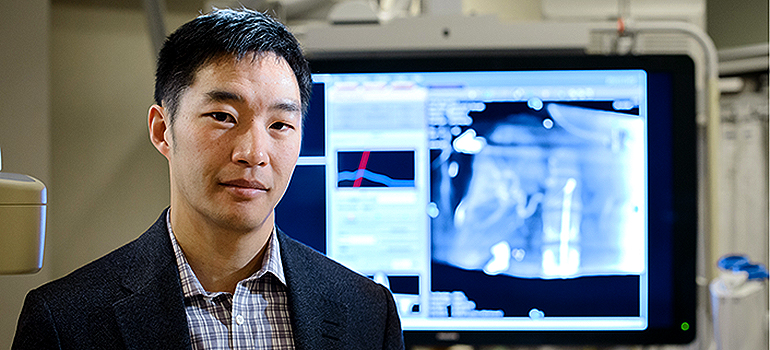Interventional radiology can be a better, safer complement to surgery, says UBC’s Dave Liu
For patients who have inoperable tumours, new developments in interventional radiology (IR) are offering new hope.
Among the youngest of medical fields – dating only to the 1960s, when Portland’s Charles Dotter invented angioplasty and the catheter-delivered stent – IR is now one of the most rapidly evolving medical sub-specialties.
Dr. Dave Liu is riding that wave’s leading edge.
“We’re trying to develop as many small, precise, elegant hammers as we can,” says Liu, a clinical associate professor in UBC’s Faculty of Medicine and one of only 11 physicians in Canada to be inducted as a fellow in the Society of Interventional Radiology.
One of the most advanced therapies he uses to treat the condition is radioembolization — the injection of radioactive particles into the vessels that feed the growing tumour. The particles lodge in the vessels, emitting radiation over several weeks; angiography is used to make sure the isotopes are placed in the precise spot.
Better, safer, faster — that’s basically what we’re trying to do.” Dave Liu
“Mother Nature has provided us, through the process of angiogenesis, with a conduit that leads directly into the heart of the tumour,” says Liu, who brought the technique to the West Coast. “It’s so focused and targeted that the normal part of the liver continues to function with only a mild degree of temporary inflammation, while the tumor is subject to lethal amounts of radioactivity.”
IR is becoming a less risky complement to surgery, since many of its procedures are done through a small incision, guided by advanced imaging technologies such as ultrasound, computed tomography, magnetic resonance imaging, and x-ray cameras.
Dr. Liu is pushing hard to keep the innovation going, and is involved in clinical research trials, including one testing the effectiveness of injecting and infecting tumours with genetically modified viruses that trigger the body’s own immune system to attack cancer cells. Vancouver is one of the 15 trial sites around the world.
Another study is seeking to determine the optimal size and composition of drug-eluting beads that release chemotherapy drugs into the tumour’s blood vessel network. He also is the Co-Chair and Co-Founder of a national expert panel exploring the best practices for management of deep vein blood clots in the legs.
Most recently, he has begun a collaboration with colleagues Anna Celler and Francois Benard in the Department of Radiology and Urs Hafeli in the Faculty of Pharmaceutical Sciences to develop the next generation of radioactive microparticles for liver cancer that are more visible, more accurate, and more easily administered.
“Better, safer, faster — that’s basically what we’re trying to do, so more hospitals can institute our techniques and ultimately, more patients can benefit from what IR has to offer,” he says.

